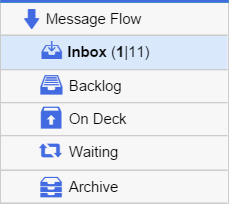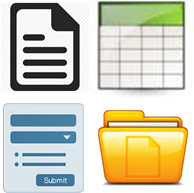Announcing TMail21
We are pleased to announce the upcoming launch of TMail21.
Here at TMail21 we are obsessed with productivity in general and enterprise productivity in particular. We’ve been dogfooding TMail internally for the past year and will shortly be starting our private beta. You can sign up for the private beta on our home page at http://tmail21.wpengine.com.
Our goal is to preserve the great characteristics of email while rethinking and reinventing its not-so-great characteristics. Finally, we take interoperation with existing email as a requirement.
Ultimately, TMail is seeking to dramatically enhance enterprise productivity by making workplace collaboration easier and more organized. In this article we’ll touch on just two problems with email (and their related solutions).
(You can visit http://tmail21.wpengine.com for a more comprehensive list of innovations that TMail introduces)
The backbone of communication and collaboration within and across enterprises is email. Like most people, there are many aspects of email we love, and many we (how to say this politely) loathe.
So, what are some things about email that drive us all crazy?
1) Email overload.
Many of us are unable to keep up with and deal with the deluge of email we get. The number one issue cited with email is the issue of email overload, stemming from two sources. The first, and easier to deal with is spam email.
In TMail we have solved this pesky problem through anti-spam features inherent to our platform. Taking into account that most spam is bot-generated, TMail distinguishes between bots and people, allowing TMail to eliminate the vast majority of spam (some of it not just annoying but actually fraudulent and a security risk to boot).
The other (and more insidious) source of email overload stems from legitimate email. Email is fundamentally an asynchronous communications tool. This asynchronous approach means that sending parties can (and often do) generate messages faster than receiving parties can process them. How do we tackle this?
The first solution is to communicate synchronously where possible. Synchronous approaches include Online Chat, Text Messaging, In-person meetings, screen-sharing, and voice calls. But with a chunk of discussion offloaded from email to chat, a new problem arises. There is no expectation in chat of follow-up. Additionally, it is very difficult to run any kind of process in chat. A lot of the chat/voice/text messaging discussions thus need to refer to the emails where follow-up or process is enabled. But there is no easy way to refer to emails. This leads to balkanization of the chat and email worlds. This dramatically reduces the effectiveness of chat since it is off in a silo by itself.
TMail solves this by assigning a unique, friendly tracking number to every TMail. With TMail the chats/voice/text-messaging discussions can refer to specific TMails. In this manner TMail bridges the gap between the synchronous and asynchronous communication worlds dramatically boosting the productivity of the former and dramatically reducing the overload on the latter. ![]()
Where synchronous communication is not possible or desirable, it is necessary to rapidly perform triage on the incoming messages. One of the most effective ways of performing triage and prioritizing work is the Kanban method of dealing with tasks. A set of ‘Kanban stages’ or folders is built right into TMail. So, messages flow from Inbox->Backlog->On Deck->Waiting->Archived.
This systematic approach to triage vastly increases triage effectiveness and follow-up. This way, a chain of communication can be paused and resumed later directly from the point of last contact, preventing any loss of workplace momentum. This approach means that TMail gives users freedom to shift from task to task seamlessly, leaving no work forgotten.
2) Attachment version nightmare.
We mail each other attachments, that others edit and mail back. Invariably, people edit the versions they weren’t supposed to edit. Information is lost, dispersed and confusion generally reigns. One solution to this is to use shared document/file systems. This is appropriate for many situations but is not a replacement for attachments because the modification to the shared document is not coordinated with the ‘send’ of the email.
This leads to disastrous effects such as a message effectively being modified after it has been sent or loss of access to the ‘attachment’ breaking some fundamental (and wonderful) paradigms of email! The TMail solution to this is that of Smart Sections.
Smart Sections have characteristics of both attachments and shared documents. Just like attachments, the release of an update is synchronized with the message-send. So, Smart Sections evolve in conjunction with the thread just like Attachments. Also, just like attachments, their ‘permissions’ are identical to that of the mail thread. So, there is no way anyone can ‘take away’ your access to a Smart Section once sent. Just like shared documents, they are designed to be updated. They are also versioned and diffable. Using these capabilities they completely eliminate attachment version nightmare and dramatically enhance productivity.
In short, Email alone cannot tackle problems and concerns teams face when looking to boost enterprise productivity. TMail is tackling this by introducing a new and more efficient way for users to collaborate, create and deliver. We aren’t just re-inventing email. We’re redefining the relationship between collaboration and communication.
To learn more about TMail you can visit
http://tmail21.wpengine.com – Home page
https://tmail21.com/why-tmail/ -Why TMail
https://tmail21.com/use-cases/ – Some uses
https://tmail21.com/tutorials/ – A video tutorial
You can also watch this introductory video







